Big-a Company inc.
Increased expectations for pallets that help reduce the drivers’ workload
*The information at the time of publication in September 2017 posted as it is.
*The company names and product names mentioned are registered trademarks or trademarks of their respective companies.
Big-a Company inc. makes full use of its own low-cost operations to develop more than 200 stores in Tokyo, Saitama, and Chiba. While constantly making efforts to reduce prices, they carefully select and handle safe and reliable quality products. Currently, they have five logistics bases and maintain a high collection rate even as a joint collection shop for JPR rental pallets. We asked Mr. Takehiro Komuro, general manager of the Logistics Systems Division, about the characteristics of the company's stores and the state of the logistics site.
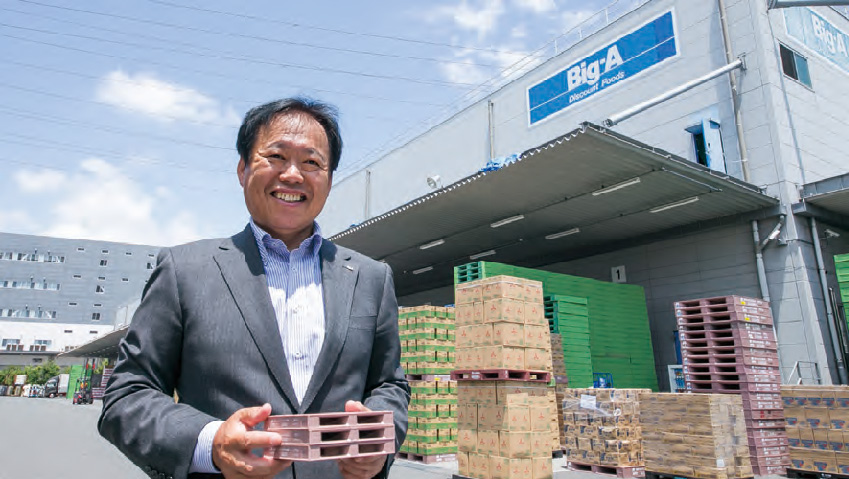
Mr. Takehiro Komuro, General Manager, Logistics Systems Division, Big-a Company inc.
Aiming to establish the only hard discount chain store in Japan
Big-a Company inc. operates a hard discount chain store mainly for fresh foods and processed foods. Established in August 1979, and in November of the same year, opened the first store in Miyahara, Omiya City (now Saitama City), Saitama Prefecture. At the time of establishment, the head office and distribution center were located in Koshigaya City, Saitama Prefecture, and since then, the number of stores has increased, mainly in the northern Kanto region. In 2003, the head office was moved to the current Itabashi Ward, Tokyo, and in 2006 the Itabashi Logistics Center was opened. "Hard discount chain stores (HDS)" are small stores opened by German hard discount store company ALDI, focusing on processed foods with a high turnover rate achieved by thoroughly reducing the cost and price. It is a retail format that sells at a super low price. The company continues to work day and night under the slogan "Establishing Japan's first and only HDS chain store."
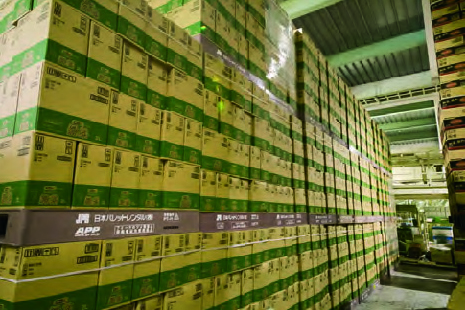
Store brand "green tea". Big-a Company inc.'s original product development achieves both high quality and low price
Mr. Takehiro Komuro, General Manager of Logistics Systems Division, Big-a Company inc., explains the company's stores as follows. "Currently, we have 215 stores in the Kanto region. Mainly sizing around 100 square meters, and recently expanded to include smaller stores of about 45 square meters."
In order to create a store that meets the needs of purchasing daily necessities with one-stop shopping, we make effective use of the small store and focus on placing product groups that meet the demand of each region.
For example, instead of selling seasonings in various sizes, they sort them out to some extent. "It's difficult to walk from end to end when shopping in a large store. With a focus on "short-time shopping," it is easy to find a product, and easy to buy so that the flow from entry to checkout can be smooth. By designing the sales floor considering the flow line elderly customers in particular are pleased. We are developing a unique store format that is neither a supermarket nor a convenience store."
The cash register payment method of placing the product from a shopping cart to another shopping cart was also the first feature in Japan. Customers can receive the paid items in a shopping cart and carry them to a car or bicycle directly. It is well received by customers where the shopping time is shortened.
Focus on own-brand labels while achieving low prices
The low price of the products can be said to be a feature of Big-a Company inc. The company has set "7 secrets of cheapness" as "paid-for shopping bags", "focusing on daily necessities", "simple display", "cash only", "simple interior equipment", "direct shipment from manufacturer" and "refraining from advertising".
In addition to these, it is said that low prices have been achieved by purchasing large quantities of products at distribution centers. "We are aiming to reduce the prices of products sold at other companies' supermarkets by about 20% at our stores. Recently, we have achieved the lowest price for 500 products in the region. We change the color of the POP advertising display for items with the lowest price in the region, so the customers can see it at a glance," says Mr. Komuro.
The company is also focusing on development of their own-brand labels. Currently, there are about 200 foods with their own-brand labels. They are characterized by being particular about domestic ingredients and using as few additives as possible.
In addition, they are developing many environmentally friendly items such as daily necessities that use plant-derived raw materials and refillable products that reduce the amount of waste.
Continuing challenging for our customers
Big-a Company inc. has many small stores, and some stores have only two employees at certain times. With this number of people, the burden of work may increase during busy hours.
Therefore, they adopted the original corrugated cardboard "SRP (shelf ready package)" that anyone can easily open and display without using a cutter. As a result, the time required to display the product has been greatly reduced. This is also one of the various ideas to realize low cost operation of stores.
Also, depending on the store, there may be experimental trials, Mr. Komuro said. "Recently, there is a store that has a section called "Deli-bake" that deals with freshly baked bread. There are about 12 types of bread at all times, and sometimes we sell 1,000 pieces in a single day. We are also selling baked sweet potatoes in more than half of the stores. We are trying various products while meeting the customer base of each store."
Expectations are high for pallets that improve work efficiency on site
The distribution center is responsible for delivering products to over 200 stores. Currently, in addition to Itabashi, there are centers in Kasukabe, Tokorozawa, Toda, and Yachiyo.
The company has five employees working in the logistics department. In addition, the on-site work of each center is outsourced to a 3PL (third party logistics) company, and the on-site work is mainly performed by staff of 3PL companies.
At logistics sites where many products are shipped and received, it is important to improve efficiency. The company is also making various efforts to move and display many products as quickly as possible. "We use a 6-wheeled trolley that is easy to move even in a small back room of the store. We call it "packing by product group, for example, a trolley with only confectionery and another with only drinks, and we ship each item by group to the store," explains Mr. Komuro.
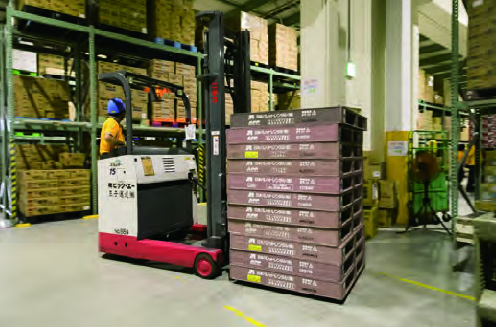
Delivery of pallets is improving the efficiency of overall logistics
Currently, about 60% of the products delivered to the company's distribution center are done by pallets. "It is easy to manage stock and inventory management on a pallet-by-pallet basis. Especially during busy periods such as before national holidays, the volume of goods will increase, so the point is to plan accurately. In addition it is good for drivers as well, with the pallets, delivery work can be significantly shortened. If it is done by hand, the work can take more than an hour which can be completed in about 15 minutes with a pallet. Naturally, the drivers are also happy using pallets. Unfortunately, the percentage of light weight products delivered with pallets is not very high, but if the pallet delivery rate increases in the future, it would make the whole distribution much efficient," says Mr. Komuro.
Over the past few years, the shortage of manpower for drivers has continued, with the long working hours, including waiting time for loading, it has become an issue.
Related ministries and agencies from Japanese Ministry of Land, Infrastructure, Transport and Tourism are taking the initiative to regulate the long working hours of drivers. There is great expectation that pallets can shorten the arrival and delivery times.
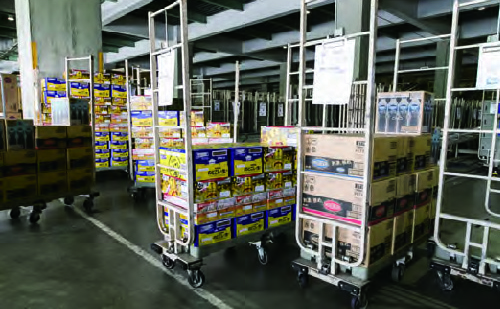
A 6-wheeled trolley with a small turning curve makes it easy to move even in a small back room of a store, leading to increased efficiency
We would love to discuss with JPR for better logistics
The company started trading with JPR in 1980, the second year of its founding. In 1995, they registered as a joint collection store of the JPR's type 11 rental pallet joint use/collection promotion association (P-Ken)*. Mr. Komuro describes the background and history as follows. "Since that time, we receive most items from JPR rental pallets, so I decided to participate because I thought it would be easier to centralize the management. Since we are able to return the pallets in a fixed time it is easier to schedule pallet organization into our workflow, which is leading to increased efficiency.
While the contractor manages the JPR rental pallets, empty pallets are returned systematically and the management is more thorough. The company's JPR pallet collection rate now boasts a high rate of over 99%.
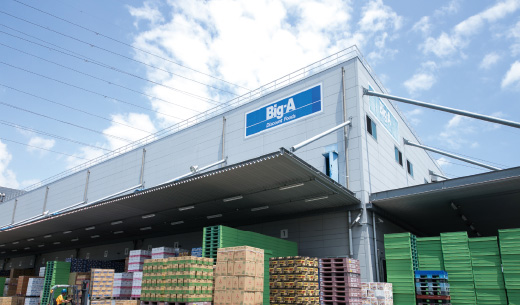
Mr. Komuro says that there are still things that can be done to improve the efficiency of logistics.
"I have been thinking together with JPR about the improvement of logistics in general, not limited to pallets. We would like to ask JPR for their continued support. In the field of logistics, new technologies are being used more and more. We would like JPR to actively provide information on such new systems. It will be a hint to further improve the efficiency of distribution centers," he said to JPR.
* JPR type 11 rental pallet joint use/collection promotion group (P-Ken): A voluntary organization that promotes integrated palletization of the processed food industry using the JPR type 11 rental pallet and a joint collection system. Established in 1990. April 2019 From "P-Ken organization" as a voluntary organization to "P-Ken system" as a business of JPR.

